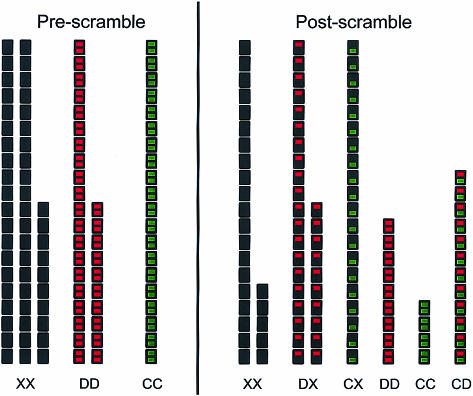Figure 8.
Model calculation to illustrate the predicted distribution of IgG4 specificities before and after scrambling (see also Appendix). X, D and C indicate the three types of IgG4 half-molecules with specificities that can be distinguished in a particular test protocol. IgG4 of type C react with the catching antigen (i.e. an allergen coated to a solid phase). IgG4 of type D reacts with the detecting antigen (i.e. a labelled fluid-phase antigen). Any other IgG4 is of type X. Starting conditions: XX = 50, DD = 30, CC = 20 (x = 0·5, d = 0·3, c = 0·2, T = 100). Final equilibrium: CC = ccT = 4; CD = 2cdT = 12; CX = 2cxT = 20; DD = ddT = 9. DX = 2dxT = 30; XX = xxT = 25. Check: 4 + 12 + 20 + 9 + 30 + 25 = 100. R = cc + 2cd + 2cx = 0·36; Q = c/(c + d/2 + x) =0·2/0·85 = 0·235. c = 1 − √(1 − R) = 1−0·8 = 0·2. capprox = Q = 0·235; cexact = Q × (1 − d/2) = 0·235 × 0·85 = 0·2.

